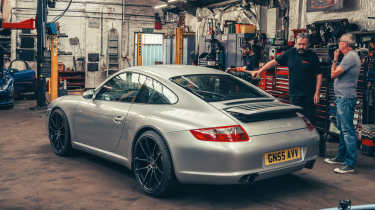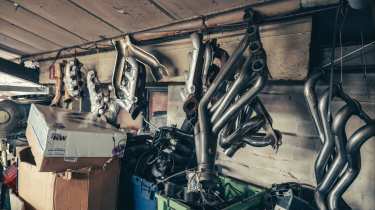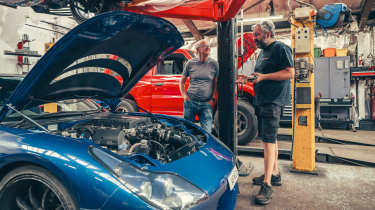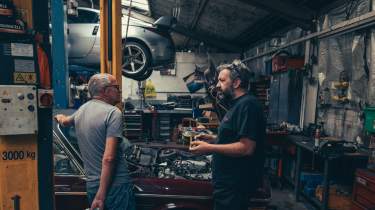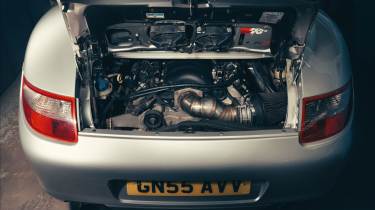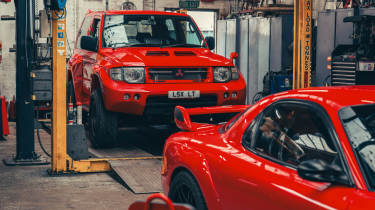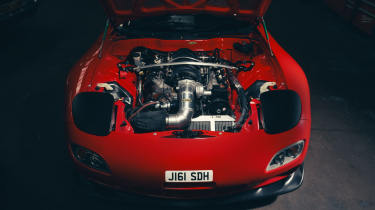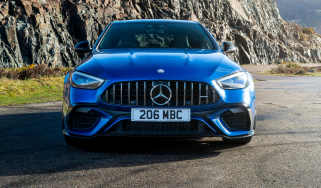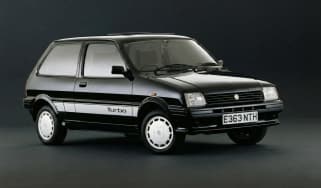This shop will swap a Corvette V8 into any car you want... incuding a Porsche 911
We meet a man who transplants Chevrolet V8s into everything from Mazda RX-7s to Porsche 911s. Genius or heretic? You decide
Regular Carrera S, silver, circa 2005. Non-standard wheels and the exhaust tailpipes are fatter than factory items, but otherwise just like any well-used 911 of 20 years of age. Tidy inside, with a manual six-speed gearbox, though the clutch seems stiffer than normal. I drove all types of 997 when they were new and at least three friends own them today, so I know them very well.
Turning the ignition key, there’s a delay before the dashboard lights come on and the starter motor engages. But the engine then fires immediately and there’s that oh-so familiar sound. Familiar, that is, if you’ve driven a Corvette, Camaro or any other of the legions of cars fitted with Chevrolet’s ubiquitous V8.
This day out to Dyno Torque in Birmingham has been in the diary for months and I can’t think of many jobs in recent years that I’ve looked forward to with such eagerness. Dyno Torque is run by 56-year-old Craig Taylor, who is Britain’s top surgeon when it comes to Chevy V8 transplants. Under his spanners, somewhere between 90 and 100 cars have been converted; some of them extremely unlikely. Even more unlikely than firing up a 911 and hearing the rumble of a V8.
Taylor served an apprenticeship with Jaguar at Browns Lane before joining the department that sorted out hard-to-solve issues with customers’ cars. He also worked occasionally on the press fleet. After Jaguar, he started his own business tuning motorcycles (and racing them). Cars, however, were always his number one passion.
‘Interestingly, it was a press preparation workshop that indirectly led to my current speciality,’ he tells me. ‘I’d bought an FD-generation Mazda RX-7 that had a dead rotary engine and had planned to fit it with a 5-litre Rover V8 that I’d built – I’d swapped a few Rover V8s into cars in the past – but was a bit worried about the standard gearbox being able to cope with the Rover’s torque.
'I was talking to a friend who worked at Vauxhall preparing press cars and he told me that a journalist had driven a brand new Monaro backwards through a hedge into a field and destroyed it. My friend said if I was having the gearbox then I might as well have the engine as well. So the whole assembly went into the Mazda.’
Taylor likes the simple life, eschewing fancy floor tiles and a glamorous workshop. And it’s just him, with help brought in when required. There’s the largest bank of tool-chests I’ve ever seen and in a separate room a very well equipped tool shop with lathes, pillar drills, milling machines and various types of welding equipment including TIG. One luxury is a laser cutting table, which Taylor says is ‘quite basic but very useful for cutting steel brackets for things like engine and accessory mounts’.
The workshop might be simple but the work performed in it certainly isn’t. Current projects include an RX‑7 with a twin-turbo V8 conversion. Taylor’s own RX‑7, by the way, ended up producing 1107bhp from its own twin-turbo V8. An RX‑8 is on the dyno, and above it on a four-post ramp is another Porsche 997, this one a Carrera 4 fitted with a LSX454 motor.
The history of the Chevrolet V8 is complicated but, put simply, the original ‘small-block’, which was launched in 1954, was revised in 1994 with the launch of the Gen II, which used electronic fuel injection. In 1997 the Gen III arrived with an alloy block and cylinder heads, still using a single in-block camshaft with pushrods and two-valve combustion chambers. General Motors called this engine the LS1.
‘We mostly use the later LS3 version of the Gen III because it’s extremely common and is available with lots of variations. There are many different oil pans or sumps, which is a real boon when you’re doing a transplant because you can choose the pan that best suits the crossmember in the car or anything else that might be an obstruction, like the steering rack. There’s also a wide choice of accessory mountings so that you can have the alternator, say, on the left or the right.’
Back to the 997 on the ramps. The LSX454 is a crate engine offered by GM Performance Parts. Like all the new engines he uses, Taylor bought it through Billy’s Speed Shop in Staffordshire. This mighty 7.4-litre engine (the standard LS3 displaces 376 cubic inches or 6.2 litres) has a steel block and is available is several different power outputs.
It’s externally the same dimensions as the Gen III; it just has bigger holes in its block. The motor in the Carrera 4 is already fitted with a pair of enormous turbos. Power output is as yet undecided but will be formidable. ‘You’ll see we’ve used factory Turbo rear wings so that we have the additional air intakes to help feed cooling to the twin intercoolers,’ points out Taylor.
Also in the shop is a Nissan 350Z fitted with an LS3 that’s nearly ready to be fired up. I’ve always thought the Z a prime candidate for a swap: they’re cheap and the standard V6 is rather lacklustre. I’ve heard of people putting Skyline engines in, but the Chevy swap makes more sense, and it’s a popular conversion in the US. ‘They tend to fit the engine further forward than we do in the 350Z,’ says Taylor, ‘but we like to get it as far back as possible for better weight distribution.
'It also means that we can use the standard radiator. We’ve learned over the years that using factory radiators is by far the best way to go. When we started doing Chevrolet swaps we had sexy-looking aluminium radiators fabricated at vast expense but we found they often failed after a short time. The factory radiators are tested in cars taken out to places like the Arizona desert and run at high speed for days at a time with all the accessories running.’
Behind the LS3 V8 in the 350Z sits an automatic gearbox, which is somewhat unexpected. ‘Personally, I’m getting more and more fond of autos,’ says Taylor.
‘They’re so good these days. This one is the ZF eight-speed that’s fitted into dozens of cars from the Jaguar XF to Volkswagen Touareg. Supply is endless and they’re not expensive. We buy the converter plate that matches the Chevrolet bolt pattern on the block to the transmission bell housing from the States because they’re so cheap.
'A pal of mine who owns a CNC machine shop says he couldn’t make the part for the $400 I pay for them.’ Interestingly, Taylor avoids DCT-type automatics, saying that the software that controls the correct amount of slippage for the double clutches is extremely complicated and hideously difficult to rewrite for the output of the Chevy motor.
An obvious question looms: how the hell do you get the Nissan ECU to be friendly with the engine and gearbox electronics? ‘It’s a good question,’ says Taylor. ‘Problems crop up that you’d never anticipate. In the Porsche 997 conversion, for example, the Chevrolet V8 warms up much more quickly than Porsche’s flat-six. This confuses the Porsche software because it thinks that the temperature sender has broken and is sending false readings. So it flags up a fault.
‘After much trial and error using various different suppliers, we now use a bespoke ECU made by a company called Emerald. The data is removed from the Porsche ECU, rewritten and then incorporated into the new Emerald ECU so that the car now knows it’s got eight cylinders, warms up faster and various other parameters. The guys at Emerald – there’s only two of them – are great and will speedily email over a patch if something’s not working quite right.’
'Engine swaps have fascinated me my whole motoring life. Partly because I love the irreverence. It wasn’t uncommon in the 1960s for Americans to put a Corvette engine into a Ferrari race car after its V12 had crapped itself. The Chev would have been cheaper and more powerful and didn’t involve having to deal with the Ferrari factory, which tended to be rather challenging.
'In the mid-’80s I had a Datsun 240Z and the specialists who looked after it had put a Chevy small-block in one. I drove it and thought it was brilliant, not least because the 2.4-litre six in the Z was anything but. To some, however, this cross-breeding is heresy.
‘We put a LS3 into a TVR Sagaris for a customer who used the car for time attack trials and, my goodness, you wouldn’t believe the flak we received from the TVR group on PistonHeads.’ Actually, I would. They’re almost as touchy as Honda S2000 owners’ groups. Some might say that TVR itself should have used a Chevrolet engine rather than develop its own AJP series. Closer to home, I nearly triggered a seizure in a Jaguar XJS-owning friend who, although a similar age to me, is still living in the late 1950s. ‘Why,’ he spluttered, ‘would you replace the Jaguar V12 with a push-rod American V8?’
Economy, reliability and power spring to my mind as Taylor shows me a photo of an XJS conversion he did for a customer. ‘We put an eight-speed auto in that car but kept the original gearlever and hid little shift buttons behind the steering wheel so that you could manually shift gears.’
I nearly talked well-known car snapper Jamie Lipman into buying a Porsche 914 with a Chevrolet small-block when he and I were at an auction near his home in Palm Springs. It’s a popular conversion in the US. A modern equivalent, also popular in the States, is fitting an LS3 into a Cayman. Sacrilegious to many but to me a very interesting technical challenge. Obviously Craig Taylor has done this swap.
‘Not one I’d tackle again,’ he says, ‘as it’s one of the most complicated jobs we’ve ever done. When the Americans do this swap they slot the engine into the standard engine bay but the accessories end up hitting the Cayman’s rear bulkhead, which means that the motor has to be moved back in the chassis. Problem with this is that the driveshafts end up at an angle that chews through universal joints very quickly. Our solution, and this is why it was so time-consuming, was to move the bulkhead itself forward by a few inches.’
A conversion that particularly intrigued me was the insertion of an LS3 into a Triumph TR4. How many DPMs (diffs per mile) does the owner get from that? ‘Ah, we used a differential from a Vauxhall Monaro driven via a Tremec gearbox,’ explains its creator.
Even before visiting Dyno Torque, any periods of insomnia have for decades been spent imagining possible small-block swaps. The most recent fantasy, having seen one go on Car & Classic for just over ten grand, is to drop an LS3 into a Ferrari 400i. The Ferrari V12 I would then put in a speedboat. I could take melatonin, but where’s the fun in that?
So, what about that Porsche-Chevrolet 997 and what is it like to drive? The engine swap was commissioned by its then owner Matthew Wells, who happens to be a senior engineer at McLaren F1 so knows a bit about vehicle dynamics and engineering.
‘I’d always wanted a 911, and particularly a 997,’ he tells me, ‘but I was on a limited budget when I bought mine and paid only £17,000 for it. I went into it well aware of the fact that it could end badly. And it certainly did. It became clear that the cylinder bores had bad scoring. I’d decided to bite the bullet and have the engine rebuilt by my local specialist. On the way there the engine totally shat itself. Rather than spend £22,000 on a new Porsche short block, I went on the internet and found Craig Taylor.’
I was only able to take a short drive in the Porsche-Chevrolet but the immediate impression is huge torque from minimal revs. And because the naturally aspirated LS3 V8 is exhaling through very short exhausts, a quite interesting note from behind.
‘The engine produces 475bhp,’ reports Wells, ‘and although we didn’t do an accurate weigh-in, the car is about 5kg lighter than with its original powertrain.’ And how about weight distribution and centre of gravity? ‘I used to be in charge of the F1 cars’ overall weight and balance so this is my world. Trust me, the slight changes in CofG and weight distribution would make virtually no difference to the car’s handling.
‘It was my daily driver when I owned it. The thing we never properly cracked was the traction control system: the car was quite a handful, particularly in the wet. I loved the car – I like cars with a bit more power than they can handle – but sold it because it was a bit full-on as an only car when you have a young family.’
Matthew Wells is full of praise for Craig Taylor’s skills. ‘He’s quite incredible. Not only the quality of his work but the speed of his mind, his problem solving, and the short timeframe he needs to take a project from the back of an envelope to a running car is hard to believe.’ Wells is clearly proud to be an ex-Dyno Torque customer. Me, I’m fantasising about becoming one.
